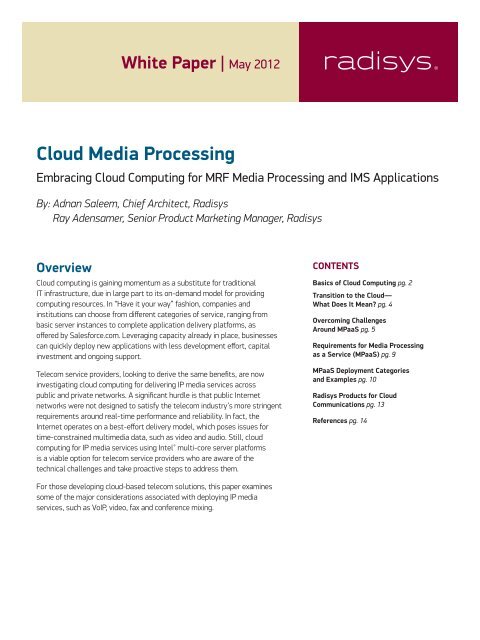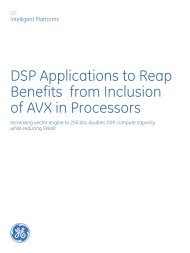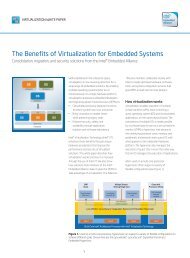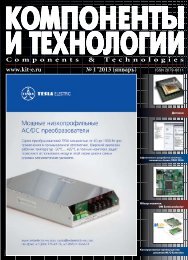Cloud Media Processing - Embedded Community - Intel
Cloud Media Processing - Embedded Community - Intel
Cloud Media Processing - Embedded Community - Intel
You also want an ePaper? Increase the reach of your titles
YUMPU automatically turns print PDFs into web optimized ePapers that Google loves.
Overview<br />
White Paper | May 2012<br />
<strong>Cloud</strong> <strong>Media</strong> <strong>Processing</strong><br />
Embracing <strong>Cloud</strong> Computing for MRF <strong>Media</strong> <strong>Processing</strong> and IMS Applications<br />
By: Adnan Saleem, Chief Architect, Radisys<br />
Ray Adensamer, Senior Product Marketing Manager, Radisys<br />
<strong>Cloud</strong> computing is gaining momentum as a substitute for traditional<br />
IT infrastructure, due in large part to its on-demand model for providing<br />
computing resources. In “Have it your way” fashion, companies and<br />
institutions can choose from different categories of service, ranging from<br />
basic server instances to complete application delivery platforms, as<br />
offered by Salesforce.com. Leveraging capacity already in place, businesses<br />
can quickly deploy new applications with less development effort, capital<br />
investment and ongoing support.<br />
Telecom service providers, looking to derive the same benefits, are now<br />
investigating cloud computing for delivering IP media services across<br />
public and private networks. A significant hurdle is that public Internet<br />
networks were not designed to satisfy the telecom industry’s more stringent<br />
requirements around real-time performance and reliability. In fact, the<br />
Internet operates on a best-effort delivery model, which poses issues for<br />
time-constrained multimedia data, such as video and audio. Still, cloud<br />
computing for IP media services using <strong>Intel</strong> ® multi-core server platforms<br />
is a viable option for telecom service providers who are aware of the<br />
technical challenges and take proactive steps to address them.<br />
For those developing cloud-based telecom solutions, this paper examines<br />
some of the major considerations associated with deploying IP media<br />
services, such as VoIP, video, fax and conference mixing.<br />
CONTENTS<br />
Basics of <strong>Cloud</strong> Computing pg. 2<br />
Transition to the <strong>Cloud</strong>—<br />
What Does It Mean? pg. 4<br />
Overcoming Challenges<br />
Around MPaaS pg. 5<br />
Requirements for <strong>Media</strong> <strong>Processing</strong><br />
as a Service (MPaaS) pg. 9<br />
MPaaS Deployment Categories<br />
and Examples pg. 10<br />
Radisys Products for <strong>Cloud</strong><br />
Communications pg. 13<br />
References pg. 14
Basics of <strong>Cloud</strong> Computing<br />
According to a US National Institute of Standards and<br />
Technology definition, “<strong>Cloud</strong> computing is a model for<br />
enabling convenient, on-demand network access to a<br />
shared pool of configurable computing resources that<br />
can be rapidly provisioned and released with minimal<br />
management effort or service provider interaction.” 1<br />
The value propositions created by readily-available<br />
computing capacity and “pay-as-you-go” are the<br />
underpinnings of an economic model made possible<br />
by service-oriented software, virtualization and grid<br />
computing technologies, among others. Strong cloud<br />
computing momentum is reflected by IDC’s 2012<br />
forecast—80 percent of new commercial enterprise<br />
applications will be deployed on cloud platforms. 2<br />
Benefits of <strong>Cloud</strong> Computing<br />
<strong>Cloud</strong> computing leverages Internet networking<br />
technology and standard servers to create financial<br />
and infrastructure benefits for service providers and<br />
their customers. Financially, service providers can<br />
achieve significant cost savings by deploying lowcost,<br />
commoditized general-purpose servers and<br />
through high equipment utilization enabled by software<br />
consolidation. The value to cloud service customers is<br />
paying only for what they use and accessing additional<br />
resources (i.e., overflow capacity) when needed without<br />
making an upfront investment. In fact, the model<br />
dramatically lowers customers’ capital expenditures,<br />
minimizes depreciation expenses and improves cash<br />
flow. Since the computing platforms are already in<br />
place, customers can deploy services more quickly<br />
than if everything had to be done from the ground up.<br />
With respect to infrastructure, cloud computing is<br />
built with fungible computing resources that can be<br />
easily re-purposed, thus extending the useful lifetime<br />
of hardware and software investments. Capacity<br />
scales easily through the addition of new <strong>Intel</strong> ® -based<br />
servers, and the homogeneity of the equipment<br />
simplifies the management of datacenters and central<br />
office systems. Furthermore, compliance strategy<br />
is easier to develop and execute because of the<br />
consistency of the infrastructure.<br />
<strong>Cloud</strong> <strong>Media</strong> <strong>Processing</strong> | Radisys White Paper<br />
Fully Integrated<br />
Application<br />
Eg: Conferencing<br />
in Private <strong>Cloud</strong><br />
Eg: Multimedia<br />
Ringback Tones,<br />
or Conferencing<br />
in Public <strong>Cloud</strong><br />
Packaged<br />
Soſtware<br />
Soſtware<br />
as a Service<br />
(SaaS)<br />
Service Models<br />
<strong>Media</strong> <strong>Processing</strong><br />
as a Service<br />
(MPaaS)<br />
Infrastructure<br />
as a Service<br />
(IaaS)<br />
Platform<br />
as a Service<br />
(PaaS)<br />
Figure 1. <strong>Media</strong> <strong>Processing</strong> as a Service (MPaaS)<br />
The cloud is capable of providing services on many<br />
levels, three categories of which are represented<br />
by the acronyms IaaS, PaaS and SaaS. These service<br />
categories are defined by TechTarget 3 as:<br />
• Infrastructure as a Service (IaaS) involves<br />
outsourcing the equipment used to support<br />
operations, including storage, hardware,<br />
servers and networking components.<br />
Eg: <strong>Media</strong><br />
Applications on<br />
Base Hardware<br />
Infrastructure<br />
Eg: Network APIs<br />
for Application<br />
Developers<br />
• Platform as a Service (PaaS) is a paradigm<br />
for delivering operating systems and associated<br />
services over the Internet without downloads<br />
or installation.<br />
• Software as a Service (SaaS) is a software<br />
distribution model in which applications are hosted<br />
by a vendor or service provider and made available<br />
to customers over a network, typically the Internet.<br />
In acknowledgment of media processing functions<br />
(see sidebar: What is a Real-time Service?), this<br />
paper introduces another type of service, referred<br />
to as “<strong>Media</strong> <strong>Processing</strong> as a Service” or MPaaS.<br />
This service model has hardware, an application<br />
programming interface (API) and application elements,<br />
so there are delivery mechanisms consistent with<br />
IaaS, PaaS and SaaS, as shown in Figure 1.<br />
2
What is a Real-time Service?<br />
<strong>Cloud</strong> <strong>Media</strong> <strong>Processing</strong> | Radisys White Paper<br />
Real-time telecom services are differentiated by the need to meet time-critical parameters, including<br />
minimal end-to-end delay and jitter, to produce an acceptable quality of experience (QoE). For audio calls,<br />
the rule-of-thumb is the round trip delay cannot exceed 150 millisecond (ms), otherwise users will hear<br />
echos and get irritated. For this reason, VoIP is a classic real-time service.<br />
Video calling and conferencing are similar to VoIP, where delay must be minimized. Video conferencing also<br />
has “lip sync” issues caused by audio and video content being transmitted from source to destination on<br />
often separate RTP media streams; consequently, their paths and delay through an IP network will differ.<br />
To remedy this situation, the streams must be buffered and put back “in sync” at the receiving end by an<br />
IP media server, thus overcoming jitter and sync problems.<br />
In contrast, receiving an email and refreshing a browser screen are examples of a near-real-time service<br />
since users can’t detect or won’t care if it takes 150 ms or longer. Although users might get frustrated<br />
with slow Internet response, in most cases they will still use the service. Similarly, a 1-way video streaming<br />
service is considered near-real-time because the end user doesn’t know when the transmission was actually<br />
sent. Even with a bogged-down public Internet, YouTube or NetFlix streams are usually good enough for<br />
users to consume and enjoy the service.<br />
A real-time service is typically a true 2-way communication experience. In a real-time service, the users<br />
can immediately tell if the service is slow or not working properly. Today, this is evident with video calling<br />
and conferencing, where it is often “hit and miss” in terms of quality when streaming across broadband<br />
and 3G networks.<br />
The following lists examples of real-time telecommunication services:<br />
• VoIP calls<br />
• Video over IP calls<br />
• Multi-media conferencing<br />
• Video content streaming<br />
• Multimedia ringback tones<br />
• Interactive voice and video response (IVVR)<br />
3
• <strong>Media</strong> <strong>Processing</strong> as a Service (MPaaS) provides<br />
access to specialized platforms, APIs or fullyintegrated<br />
applications that analyze and modify<br />
media data streams. These applications leverage<br />
functions such as audio and video mixing,<br />
multimedia transcoding, recording and playing<br />
a media stream, detecting the “loudest talker”<br />
or noisy connections, and applying voice or video<br />
quality enhancements.<br />
Types of <strong>Cloud</strong> Computing<br />
<strong>Cloud</strong>s are classified as public, private, hybrid or<br />
community, based on the entities providing computing<br />
resources and networks. A public cloud uses the<br />
mainstream public Internet, which is operated by<br />
and shared across many external organizations.<br />
This model is typical for hosted conferencing service<br />
providers. A private cloud is operated for a single<br />
organization and is common among enterprises for<br />
data security, corporate governance and reliability<br />
reasons. A hybrid cloud combines both public and<br />
private clouds. A community cloud is setup for a<br />
common interest group, and the infrastructure is<br />
maintained by its members.<br />
Transition to the <strong>Cloud</strong>—<br />
What Does It Mean?<br />
<strong>Cloud</strong> computing is creating a paradigm shift that<br />
is closely aligned to guiding tenets around how<br />
computing resources are accessed and consumed,<br />
some of which are listed in Table 1. As a result,<br />
customers of cloud services can take advantage of<br />
new features, like dynamic resource allocation and<br />
consumption-based pricing models, that increase their<br />
agility and flexibility.<br />
From the perspective of telecom service providers,<br />
an industry migrating to cloud-based services is<br />
likely to experience fundamental shifts related to<br />
infrastructure, business models and competition.<br />
Drawing on insights from Morgan Keegan 5 at Equity<br />
Research, some of these changes include:<br />
<strong>Cloud</strong> <strong>Media</strong> <strong>Processing</strong> | Radisys White Paper<br />
Tenets Implications<br />
Abstract Resources Substitute references to physical servers<br />
and hard drives with instances and volumes.<br />
<strong>Cloud</strong> resources are fungible. 4<br />
On-Demand Provisioning Get more resources right when they’re needed.<br />
Give back unnecessary resources.<br />
Scalability in Minutes Scale out or in depending on usage needs.<br />
Pay per consumption Don’t pay for resources after they’ve been turned off.<br />
Automation Increase automation using APIs. The cloud provides<br />
access to scriptable infrastructure.<br />
Table 1. Tenants of <strong>Cloud</strong> Computing<br />
Infrastructure:<br />
• New on-premises infrastructure deployments<br />
give way to cloud-based systems located offsite.<br />
• Transcoding-intensive digital signal processors are<br />
substituted with virtualized COTS infrastructure<br />
based on <strong>Intel</strong> ® multi-core processor technology.<br />
• Large, upfront equipment expenditures are replaced<br />
by recurring fee (rent) payment models.<br />
Business Model:<br />
• ‘Conferencing as a business’ transitions to<br />
‘conferencing as a service.’<br />
• Interoperability requirements expand from<br />
dedicated equipment to all computing devices.<br />
Competition:<br />
• New entrants take advantage of lower barriers<br />
to entry provided by cloud computing.<br />
• Greater reliance on public networks levels the<br />
playing field.<br />
• Improved interoperability enables new partnership<br />
opportunities.<br />
4
Overcoming Challenges<br />
Around MPaaS<br />
The motivations for the industry to consider cloud<br />
computing, and more specifically media processing as<br />
a service, are usually grounded on the financial benefits.<br />
That is why cloud computing is also characterized as a<br />
financial model first, but then also needs to be balanced<br />
with technical realities in delivering a real-time<br />
telecommunications service.<br />
Leveraging cloud computing for IP media services<br />
requires changes to the underlying network architecture<br />
in order to adapt the new ways data and applications<br />
will move between customer machines and central<br />
offices/data centers. For example, public access<br />
networks need to be upgraded to deliver greater<br />
bandwidth, higher quality of service (QoS) and improved<br />
reliability, among other things. Moreover, MPaaS must<br />
run on shared computing platforms and meet stringent<br />
QoS requirements despite the reliance on public<br />
networks, which are far less predictable than private<br />
networks. The following sections describe many of<br />
the challenges facing networking and telecom solution<br />
providers in the delivery of MPaaS, and how Radisys<br />
solutions are helping to address them.<br />
Real-time Network Performance<br />
Traditional Internet applications do not have strict<br />
real-time performance constraints. Most users wouldn’t<br />
complain if a web page download took a half second or<br />
longer, whereas such a delay is unacceptable for audio<br />
and video communications. Based on user perception<br />
studies, most people consider the benchmark of 150<br />
milliseconds (ms) as the maximum tolerable delay for<br />
a satisfactory voice call. If the delay is greater, users<br />
will notice the delay, which will negatively impact the<br />
communications experience.<br />
Today, many telecom service providers choose to<br />
purchase their own IP media processing equipment<br />
and QoS-enabled IP network infrastructure in order<br />
to deliver the real-time network performance needed<br />
to ensure an acceptable quality of experience (QoE)<br />
for subscribers. Likewise, control over equipment is<br />
especially critical for service providers who implement<br />
<strong>Cloud</strong> <strong>Media</strong> <strong>Processing</strong> | Radisys White Paper<br />
virtual private networks (VPNs) designed to improve IP<br />
communications quality through better performance,<br />
lower delay and less jitter than the Internet. When<br />
quality of experience is a top priority, it’s imperative<br />
that service providers test the end-to-end network<br />
performance of IP media services at maximum load.<br />
The same is true for those deploying IP media services<br />
on cloud infrastructure; it is important to closely look<br />
at the network performance, along with the costs for<br />
delivering that performance, with your service provider.<br />
Radisys Solution: Real-time performance is<br />
designed into Radisys media servers, enabling both<br />
DSP hardware-based and software-based versions<br />
in virtualized environments running on <strong>Intel</strong> ® multicore<br />
processors to satisfy comparable latency<br />
specifications. Employing patented technology,<br />
all Radisys media servers (see sidebar: <strong>Media</strong><br />
Servers in the <strong>Cloud</strong>) implement a real-time control<br />
layer that sits on top of the operating system. This<br />
layer enhances DSP, multi-core and multi-processor<br />
architectures by providing real-time optimizations<br />
specifically tuned for the deterministic response<br />
times needed for IP media processing.<br />
The Radisys Software <strong>Media</strong> Server also utilizes<br />
<strong>Intel</strong> ® Integrated Performance Primitives (<strong>Intel</strong> ® IPP)—<br />
an extensive library of multi-core-ready, highly<br />
optimized software functions for multimedia and<br />
communications applications. <strong>Intel</strong> ® IPP functions<br />
deliver parallel performance beyond what optimized<br />
compilers alone can deliver, enabling Radisys to<br />
execute packet and jitter buffer processing within<br />
the strict 5-millisecond packet processing increments<br />
required by in high-performance telecommunication<br />
applications using Real-time Transport Protocol<br />
(RTP) media streams.<br />
In addition, the resource manager differentiates<br />
processing tasks (‘hard-real-time’ versus ‘nearreal-time’)<br />
and distributes them independently.<br />
Ensuring the hard-real-time processes have sufficient<br />
computing power, the resource manager reallocates<br />
CPU, DSP, memory and I/O resources as needed.<br />
This optimizes application performance based on<br />
the available computing resources, thus reducing<br />
cost for a given performance level.<br />
5
Availability and Reliability<br />
Representing the gold standard for reliability, carriergrade<br />
equipment is known for “five-nines” availability,<br />
which is often bolstered by robust failover. <strong>Cloud</strong>-based<br />
infrastructure supporting telecom services should<br />
integrate the hardware and software components<br />
capable of maintaining equivalent availability.<br />
Radisys Solution: Radisys Software <strong>Media</strong> Server,<br />
running on the carrier-grade Red Hat Linux operating<br />
system, can be deployed on a commercial-off-the-shelf<br />
(COTS) Linux appliance or blade servers, as well as<br />
AdvancedTCA-based computers delivering five-nines<br />
availability such as Radisys ATCA Compute <strong>Processing</strong><br />
Modules based on <strong>Intel</strong> ® multi-core architecture.<br />
Resource Allocation<br />
As mentioned earlier, on-demand provisioning is<br />
a key tenet of cloud computing, which requires an<br />
infrastructure resource manager capable of adding<br />
burst capacity, when needed. Resource managers<br />
may also be called upon to route workloads to certain<br />
nodes, perform load balancing and manage a cluster<br />
of resources. These tasks must be carried out with the<br />
understanding that some computing resources may<br />
perform specific media services, like text to speech, pure<br />
transcoding or multi-media processing. Some scenarios<br />
that resource allocation should comprehend include:<br />
• Resource Management—Customers pay for<br />
what they need per service level agreement; and<br />
accordingly, the resource manager assigns servers<br />
and balances the load among all the resources.<br />
For example, a customer requests six servers total,<br />
where five are dedicated to media services and one<br />
to transcoding.<br />
• Burst Capacity—As an example, audio conferencing<br />
has a peak time, typically during work hours. After<br />
that time, a customer chooses to release the cloud<br />
resources to lower cost or to enable other services<br />
to reuse the same cloud infrastructure.<br />
• Geographic Resource Management—Services<br />
and features are tailored to individual geographies,<br />
making it necessary to manage dissimilar installations.<br />
• Server Redundancy—In the event of server failure,<br />
the cloud maintains a redundant server for failover<br />
to minimize disruption.<br />
<strong>Cloud</strong> <strong>Media</strong> <strong>Processing</strong> | Radisys White Paper<br />
<strong>Media</strong> Servers in the<br />
<strong>Cloud</strong>: Hardware-based<br />
and Software-based<br />
<strong>Cloud</strong> service providers offering media<br />
processing services have the option of deploying<br />
hardware- or software-based media servers,<br />
or a combination. For example, Radisys offers<br />
both types of media servers designed for<br />
real-time media processing performance.<br />
• MPX-12000<br />
˸ Broadband <strong>Media</strong><br />
Resource Function (MRF)<br />
˸ Voice and video over<br />
LTE (VoLTE)<br />
˸ ATCA-based system can<br />
integrate load balancing blades<br />
• CMS-9000<br />
˸ High density, faulttolerant<br />
and NEBS<br />
compliant<br />
˸ Scalable up to<br />
22,800 ports<br />
• Radisys Software <strong>Media</strong> Servers<br />
˸ Runs on COTS Linux servers<br />
based on <strong>Intel</strong> ® multi-core<br />
processors, including the<br />
<strong>Intel</strong> ® Xeon ® processor<br />
E5 family<br />
˸ Patented design to maximize real-time<br />
performance under high system load<br />
˸ Utilizes <strong>Intel</strong> ® Integrated Performance<br />
Primitives (<strong>Intel</strong> ® IPP)—an extensive library<br />
of multi-core-ready, highly optimized<br />
software functions for multimedia<br />
and communications applications<br />
˸ Ongoing optimization for virtualized<br />
environments<br />
6
Radisys Solution: Radisys continues to improve<br />
our unique application programming interface (API)<br />
that allows cloud providers to monitor media server<br />
resource utilization (e.g., how many resources are<br />
still available) in real-time, thus greatly facilitating<br />
load balancing. Radisys also exposes measurements<br />
and statistics for any running instance. As a result,<br />
Radisys media servers are easy to manage on a per<br />
instance basis or cluster basis in the cloud.<br />
<strong>Media</strong> <strong>Processing</strong> in Virtual Machines<br />
When implementing software-based media servers,<br />
virtualization (see sidebar: Virtualization Technology)<br />
gives service providers far more flexibility to add/<br />
remove services and features on the fly. This is<br />
because the software providing services/features run<br />
in virtual machines that can be deployed/undeployed<br />
while the server is running. This capability can be<br />
used to satisfy the abstraction and scaling tenets of<br />
cloud computing described earlier. However, caution<br />
is needed when using virtualization since it can slow<br />
down systems, as well as introduce unpredictable<br />
behavior that negatively impacts real-time<br />
performance, especially under high load.<br />
Radisys Solution: Radisys Software <strong>Media</strong> Server<br />
has been successfully tuned and tested on VMware,<br />
running on an <strong>Intel</strong> ® multi-core server. Radisys<br />
customers have also reported virtualized operation<br />
on Linux KVM. Radisys Software <strong>Media</strong> server will<br />
soon be properly productized and supported on these<br />
and other virtualization products in the future. Using<br />
virtualization, service providers can easily deploy<br />
multiple instances of the Radisys Software <strong>Media</strong><br />
Server to increase media processing capacity.<br />
Another usage is to enhance reliability by creating<br />
a backup copy that is a hot standby media server<br />
in a virtual machine.<br />
<strong>Media</strong>, Control and Access Security<br />
Storing company information in the cloud can be risky,<br />
therefore incorporating encryption and authentication<br />
technology is critical, particularly for public clouds.<br />
Radisys Solution: Radisys implements standard<br />
security protocols to protect IP flows.<br />
<strong>Cloud</strong> <strong>Media</strong> <strong>Processing</strong> | Radisys White Paper<br />
Virtualization Technology<br />
Virtualization is commonly discussed in the context of cloud<br />
computing. The technology has been around for many years,<br />
most notably used in data centers where various applications are<br />
consolidated onto a single server. Virtualization software, called<br />
a hypervisor, abstracts a computer’s resources (CPU, memory,<br />
I/O, etc.) and creates virtual machines that act like independent<br />
computers with an operating system, memory, disk and an<br />
application. VMware and Linux KVM are examples of hypervisors,<br />
also called virtual machine monitors.<br />
Of concern to telecom application developers is the overhead<br />
introduced by hypervisors, particularly when the computer<br />
switches between virtual machines. This delay can diminish<br />
deterministic, real-time performance and lead to unexpected<br />
behavior. As a result, developers should take steps to ensure<br />
their software can run in a virtualized environment without<br />
perceptible performance degradation. This includes thorough<br />
end-to-end service testing—especially when the cloud media<br />
processing and associated cloud network infrastructure is under<br />
high system load.<br />
Therefore, telecom service providers should weigh the potential<br />
impact, both cost and performance, of a virtualized cloud<br />
infrastructure. There may be one option where a server instance<br />
runs un-virtualized on its own dedicated <strong>Intel</strong> ® computing platform,<br />
and another, where many virtual server instances run on the same<br />
physical machine.<br />
• <strong>Media</strong> Plane—The Secure Real-time Transport<br />
Protocol (SRTP) supports encryption and message<br />
authentication. Note: SRTP is an adaptation of the<br />
Real-time Transport Protocol (RTP).<br />
• Control Plane—Internet Protocol Security (IPsec)<br />
and Transport Layer Security (TLS) secure<br />
IP communications by authenticating and<br />
encrypting packets.<br />
• Operations and Management—Hypertext Transfer<br />
Protocol (HTTP) is an application protocol for<br />
distributed, collaborative, hypermedia information<br />
systems. 6 Radisys is implementing the HTTP<br />
combined with TLS, called HTTPS, in the future.<br />
7
Service-Aware Load Balancing<br />
and Traffic Redirection<br />
Load balancing is an essential aspect of managing the<br />
workload sent to media servers because it optimizes<br />
resource utilization and minimizes bottlenecks that<br />
impact performance. Another important workload<br />
Load Balancing<br />
<strong>Cloud</strong> <strong>Media</strong> <strong>Processing</strong> | Radisys White Paper<br />
management task is traffic redirection, which is<br />
prevalent in teleconferencing. For example, a<br />
conference call may have three participants calling<br />
into the cloud, and all of the messaging and signalling<br />
needs to be routed to the single node supporting<br />
the call. Multi-party services and collaboration<br />
can make traffic redirection more complicated.<br />
Within the cloud, many identical servers may be required to provide services for many thousands<br />
(if not millions) of individual clients. Therefore, a vital component of a cloud service platform is the<br />
module that distributes traffic evenly across a dedicated bank of servers.<br />
Radisys offers two types of solutions for providing the load balancing function in an ATCA chassis. The<br />
first, ‘wirespeed’ load balancing, resides on the ATCA chassis’ internal switch/hub. The second, which<br />
provides an intelligent adaptable load balancing solution, is a software technology called ‘FlowEngine,’<br />
designed to run on the Radisys family packet processing blades based on NetLogic and Cavium processors.<br />
Wirespeed load balancing leverages functions inherent within the switching silicon itself to parse packet<br />
headers for the fields that contain the identity of the particular user (client) or flow and to use the values<br />
found to select a service blade or thread to process the packet. Since the switch is able to perform this<br />
function on packets as they are received directly off the ingress port, there is very little additional latency.<br />
The switch can load balance all external facing ports at the full line data rate.<br />
A potential limitation of switch based load balancing is that the forwarding decision has to be made on a<br />
completely stateless basis. This means the identification of the target for the packet is derived solely as a<br />
mapping (or hash) of the bits in the relevant header fields. The target cannot be specifically assigned when<br />
any one connection is first made. In the context of a media server platform, where conferencing is a common<br />
requirement, it is important that packets belonging to a particular call can be sent to a specific blade. To<br />
address the requirement, FlowEngine-based intelligent load balancing is often a more appropriate solution.<br />
FlowEngine is a software technology that allows Radisys to create application-specific load balancing<br />
appliances on top of an ATCA packet blade. Such intelligent load balancers are able to look-up key packet<br />
header fields or hashes in a table to see if the packet belongs to a known connection or if it belongs to<br />
a new one (a previously unseen user/session), in which case a new forwarding rule has to be created.<br />
The new forwarding connection can be based upon a weighted round robin snapshot of recent server<br />
loadings or can be specifically created as part of the process of setting up the session/call by the control<br />
plane part of the media server platform.<br />
Both switch and FlowEngine-based load balancing provide high availability features to respond to the<br />
failure of a load-balanced service blade. Packets destined for the failed blade can either be redirected to<br />
a standby blade, or if a standby is not available, they can be distributed among the server blades which<br />
remain in service. Once the failed blade is restored, the load balancer can either return packets back to<br />
the original target, or in the case of FlowEngine, minimize further session disruption by using the restored<br />
blade only for new users/sessions as they appear.<br />
8
Radisys Solution: Radisys media processing<br />
solutions can be delivered with other Radisys<br />
products, including ‘wirespeed’ load balancing on<br />
ATCA chassis internal switch/hub. Alternatively, a<br />
Radisys software technology called ‘FlowEngine’<br />
can deliver load balancing on the Radisys family<br />
of NetLogic and Cavium-based packet processing<br />
blades (see sidebar: Load Balancing)<br />
Developer API’s and Interfaces<br />
Developers of telecom applications need<br />
straightforward mechanisms to invoke media services<br />
that are compatible with a diverse set of application<br />
development and run-time environments. This<br />
typically entails an API that makes it easier to<br />
support multiple client platforms, such as Internet<br />
browsers, smart phones, tablets, laptops, etc.<br />
Radisys Solution: Radisys media servers support<br />
standard-based APIs, including:<br />
• Session Initiation Protocol (SIP) is an IETF-defined<br />
application-layer control (i.e., signaling) protocol for<br />
creating, modifying and terminating sessions with<br />
one or more participants. These sessions include<br />
Internet telephone calls, multimedia distribution<br />
and multimedia conferences. 7<br />
• VoiceXML (VXML) is the W3C’s standard XML<br />
format designed for creating audio dialogs that<br />
feature synthesized speech, digitized audio,<br />
recognition of spoken and DTMF key input,<br />
recording of spoken input, telephony and mixed<br />
initiative conversations. 8<br />
• <strong>Media</strong> Server Markup Language (MSML), described<br />
in RFC 5707, 9 is designed to provide feature–<br />
rich media processing control in an IP–based<br />
communications network. MSML has been adopted<br />
by dozens of vendors and is used to control many<br />
millions of IP media server ports in numerous<br />
service provider networks around the globe.<br />
• HTTP RESTful Interfaces, soon to be supported by<br />
Radisys, are growing in popularity because they are<br />
a good fit for cloud and other Web-based services<br />
due to their HTTP synergies and client-side scripting<br />
capabilities (e.g., web browsing). For example, JSON<br />
(Javascript Object Notation) or XML-encoded media<br />
control functions are well-suited for mobile web<br />
<strong>Cloud</strong> <strong>Media</strong> <strong>Processing</strong> | Radisys White Paper<br />
applications employing media services hosted in<br />
the cloud. In comparison, the protocols previously<br />
discussed are better suited for non-IP-based<br />
telephony.<br />
Requirements for <strong>Media</strong><br />
<strong>Processing</strong> as a Service<br />
(MPaaS)<br />
<strong>Cloud</strong> computing is capable of supporting media<br />
processing services, due in large part to significant<br />
advances in computing and IP networking technology<br />
that are enabling a new class of real-time telecom<br />
services. The stringent performance requirements of<br />
MPaaS can be met, in many cases, by existing cloud<br />
network elements. Special considerations, in order<br />
of importance, are outlined in the following, where<br />
MPaaS is compared to other applications moving<br />
to the cloud.<br />
• Network I/O and Associated Load/Traffic<br />
Management—High Importance<br />
˸ <strong>Media</strong> processing controls and manipulates<br />
IP media streams, and like other applications<br />
involving multiple video sources, it can consume<br />
a large amount of network bandwidth.<br />
˸ High-quality network connections are critical<br />
to avoid network jitter, which can significantly<br />
impair the quality of experience (QoE).<br />
• Compute Resources—Medium Importance<br />
˸ <strong>Media</strong> processing is computing intensive,<br />
as are many other applications.<br />
• Element Management—Medium Importance<br />
˸ Perhaps more distributed than most applications,<br />
media processing can be complex to manage,<br />
especially when a service provider’s solution<br />
spans in-house service infrastructure and<br />
outsourced cloud computing infrastructure.<br />
• Billing—Low Importance<br />
˸ Billing is obviously an important aspect of a cloud<br />
media processing service. While normally not a<br />
function or top concern for the media processing<br />
layer, billing grows in importance when the<br />
service offering involves customer-facing<br />
application layer elements.<br />
9
• Storage—Low Importance<br />
˸ Comparatively, media processing typically<br />
requires minimal storage, unless the application<br />
uses a media library, like a multimedia ringback<br />
tone database.<br />
The cloud service providers best positioned to provide<br />
MPaaS have high-quality network connections and<br />
supporting QoS mechanisms. However, the costs<br />
to deploy high-performance network I/O can be<br />
considerable—often much higher than the compute<br />
resources themselves.<br />
For this reason the CFO, who likes the financial<br />
benefits of cloud media processing, should work<br />
together with the telecom engineers and service<br />
planners to achieve a balance between economic and<br />
quality aspects. They must identify when it makes<br />
sense to migrate media processing from a controlled,<br />
properly engineered, private telecom IP network, to<br />
a cloud environment that often has many variables<br />
and unknowns. For example, one strategy might<br />
involve a tiered approach such as:<br />
• Economical Telecom Services, which leverage cloud<br />
media processing and the associated cost benefits,<br />
are suitable for lower-end, price-sensitive service<br />
offerings.<br />
• Premium Telecom Offerings, which use existing,<br />
dedicated data center and IP VPN infrastructure,<br />
continue to deliver the highest quality of experience.<br />
MPaaS Deployment<br />
Categories and Examples<br />
When MPaaS (<strong>Media</strong> <strong>Processing</strong> as a Service) was first<br />
mentioned in this paper, it was suggested this service<br />
type fits into the most common cloud computing<br />
service models. This point is illustrated in Figure 2<br />
and described in more detail in the following:<br />
• Infrastructure as a Service (IaaS)<br />
˸ <strong>Media</strong> processing services running on virtualized<br />
and media-optimized compute resources,<br />
network I/O and storage.<br />
<strong>Cloud</strong> <strong>Media</strong> <strong>Processing</strong> | Radisys White Paper<br />
Laptops<br />
SaaS<br />
PaaS<br />
IaaS<br />
Phones<br />
Monitoring<br />
• Platform as a Service (PaaS)<br />
˸ Application developers accessing media<br />
processing services using API’s and standard<br />
interfaces to enable mobile and wireline<br />
communications applications that leverage the<br />
cloud media platform and associated resources.<br />
• Software as a Service (SaaS)<br />
Servers<br />
Application<br />
Collaboration Finance<br />
Content Communication<br />
Platform<br />
Identity Queue<br />
Object Storage Runtime Database<br />
Infrastructure<br />
Compute Network<br />
Block Storage<br />
Figure 2. <strong>Media</strong> <strong>Processing</strong> as a Service (MPaaS) Aligning with<br />
Common <strong>Cloud</strong> Computing Service Models<br />
˸ <strong>Cloud</strong> hosted, fully-integrated communications<br />
services and applications, such as multimedia<br />
conferencing or communications portals, with all<br />
the necessary management and billing services<br />
included as part of the service.<br />
<strong>Media</strong>-Optimized Elements<br />
in the <strong>Cloud</strong>—IaaS Model<br />
Today, most telecommunication service providers have<br />
their own infrastructure, purchasing IP media server<br />
equipment and deploying it in their central offices<br />
or datacenters. With cloud computing, it’s no longer<br />
necessary to make this large investment; instead,<br />
service providers can get media processing capacity<br />
from cloud service providers on a pay-as-you-go<br />
basis. This kind of arrangement is likely to employ<br />
a private cloud, and a single cloud service provider<br />
would host some or all of the service provider’s<br />
media processing requirements and capacity.<br />
Desktops<br />
Tablets<br />
10<br />
<strong>Media</strong><br />
Integrated<br />
Apps<br />
<strong>Media</strong><br />
APIs &<br />
Interfaces<br />
<strong>Media</strong><br />
Optimized<br />
Elements
To better serve cloud computing customers, media<br />
server vendors (i.e., equipment manufacturers) are<br />
optimizing media processing elements to enhance<br />
performance in these environments. Moreover, mediaoptimized<br />
elements will ease the deployment and<br />
provisioning of media processing capacity, and leverage<br />
virtualization technology to increase the flexibility<br />
and cost efficiencies availed by cloud computing<br />
infrastructure. For instance, web service provider<br />
Amazon offers their Elastic Compute <strong>Cloud</strong> (Amazon<br />
EC2 10 ), where media processing elements could be<br />
optimized for rapid deployment to support on-demand<br />
resizable media processing capacity in the cloud.<br />
Example: <strong>Cloud</strong> <strong>Media</strong> <strong>Processing</strong><br />
for Peak Capacity<br />
A successful service provider offering hosted telecom<br />
services has a growing business and needs to<br />
increase its capacity. Rather than increase capital<br />
expenditures (CapEx) to fund more infrastructure,<br />
the service provider obtains additional capacity<br />
from a cloud service provider during peak demand,<br />
just a few hours a day (Figure 3). When evaluating<br />
cloud service vendors, the telecom service provider<br />
considered network I/O costs, connectivity quality and<br />
overall network performance with respect to jitter,<br />
delay and QoS. Another key aspect was ensuring the<br />
management features could seamlessly integrate<br />
and hand-off calls from the existing infrastructure<br />
to the cloud provider.<br />
The cloud service provider offering included hosted<br />
media servers whose resources were partitioned as<br />
virtualized instances, allowing them to be provisioned<br />
and used, as required, during peak periods. In other<br />
words, the virtualized instances could be activated<br />
and brought online during peak periods, and later<br />
released when demand decreased.<br />
Benefits of outsourcing for service providers:<br />
• Saves capital and operating expenditures<br />
(CapEx/OpEx) to enable future growth.<br />
• Allows media processing resources to<br />
be gradually migrated to the cloud.<br />
<strong>Cloud</strong> <strong>Media</strong> <strong>Processing</strong> | Radisys White Paper<br />
Configure Network<br />
for Normal Traffic<br />
• Service Provider<br />
provisions infrastructure<br />
for normal traffic volumes<br />
Service<br />
Provider<br />
Application<br />
Server (AS)<br />
IP <strong>Media</strong><br />
Server (MRF)<br />
Use IaaS <strong>Media</strong><br />
<strong>Processing</strong> During<br />
Peak Traffic<br />
• Provision and utilize media<br />
processing instances<br />
during peaks<br />
• Service Provider AS routes<br />
overflow calls to cloud<br />
media processing<br />
• Turn off when daily peaks<br />
completed<br />
• Enables tiered-service offerings.<br />
<strong>Cloud</strong> <strong>Media</strong><br />
Services<br />
Provider (IaaS)<br />
Virtualized<br />
<strong>Media</strong> Resources<br />
˸ Premium (highest QoS): uses the service<br />
provider’s internal network and infrastructure.<br />
˸ Economy (satisfactory QoS): uses the cloud.<br />
APIs and Interfaces for <strong>Media</strong><br />
Services—PaaS Model<br />
Service providers are looking for new ways to offer<br />
real-time media processing services, in addition to<br />
hosting their own services. One promising avenue is<br />
to open up their platforms to third party developers,<br />
whose applications would interface with and utilize<br />
their real-time media processing as a service (MPaaS).<br />
This business model could be supported by the public<br />
cloud, which could also handle the billing for third parties.<br />
To pursue this opportunity, service providers must<br />
expose their media service APIs and interfaces in<br />
languages and formats that can be utilized by the<br />
broadest cross-section of the software engineering<br />
industry. The pool of software engineers that develop<br />
applications using SIP or other telecom-specific APIs<br />
make up only a small percentage of the software<br />
Consistent End<br />
User Experience<br />
• Same service quality,<br />
features and performance<br />
24/7<br />
11<br />
PSTN<br />
Phone<br />
2G<br />
Cellular<br />
Laptop<br />
with VoIP<br />
Client<br />
LTE<br />
Smartphone<br />
with App<br />
Figure 3. Outsourcing <strong>Media</strong> <strong>Processing</strong> to Add Capacity During Peak Demand
engineering industry. Instead, service providers should<br />
embrace more commonly-used Java or HTTP-based<br />
protocols. Moving forward, there are new standards<br />
under development to better support these business<br />
models, including JSR-309 for Java-based media<br />
control development and RESTful HTTP interfaces<br />
for control. 11<br />
Example: <strong>Cloud</strong> <strong>Media</strong> <strong>Processing</strong><br />
for 3rd Party Developers<br />
A web-based contact center determines it could<br />
dramatically increase the efficiency of its support<br />
team using real-time audio/video communication<br />
features. For instance, customer contact begins<br />
with an over-the-web chat session, but then, using<br />
a “hotkey,” the customer can quickly start a 1-on-1<br />
real-time conversation with a customer service<br />
representative or product specialist. Tasked with<br />
creating this feature, an application developer<br />
reprograms the contact center’s call flow to<br />
incorporate the new real-time audio/video<br />
communication features, which the contact center<br />
accesses in the cloud, as illustrated in Figure 4.<br />
Example: RCS Video Services<br />
(Rich Communications Suite-enhanced)<br />
The GSMA driven RCS-e industry initiative is gaining<br />
widespread momentum within operators, device<br />
manufacturers, and application service providers.<br />
An important component of RCS-e is multimedia/<br />
video share and video calling services operated and<br />
provided through carrier networks. Interoperability<br />
across a diverse set of handhelds, media codecs/<br />
formats, bandwidth optimization, and inter-carrier<br />
media connects and interworking are well identified<br />
challenges. Hosting RCS-e video as part of a <strong>Cloud</strong><br />
Service adds significant value to overcome the<br />
interoperability issues where the <strong>Cloud</strong> Services can<br />
be shared and the required <strong>Media</strong> <strong>Processing</strong> within<br />
the <strong>Cloud</strong> would provide seamless interoperability<br />
across RCS and non-RCS handhelds as well as<br />
inter-carrier networks, in real-time. 12<br />
Benefit of open platforms for MPaaS providers:<br />
• Generates new services and associated revenues<br />
driven by the imagination of application developers<br />
around the globe.<br />
<strong>Cloud</strong> <strong>Media</strong> <strong>Processing</strong> | Radisys White Paper<br />
Customer Care<br />
Interactive Web<br />
Session<br />
IP Access<br />
Internet, IP VPN<br />
LTE Mobile<br />
Real-time N-way<br />
Conferencing Session<br />
<strong>Cloud</strong> Customer<br />
Care Service<br />
Customer Care<br />
SaaS Application<br />
“Click to Conference”<br />
Request<br />
Web-based APIs<br />
MPaaS<br />
Conferencing<br />
Application<br />
<strong>Cloud</strong><br />
Communications<br />
Service<br />
Figure 4. <strong>Cloud</strong> <strong>Media</strong> <strong>Processing</strong> for 3rd Party Developers in LTE Mobile Network<br />
Telecommunication Applications as<br />
<strong>Cloud</strong> Service Offerings—SaaS Model<br />
After making significant investments in unified<br />
communications (UC) infrastructure, some<br />
enterprises would like to transfer some of the<br />
support responsibilities to a third party. This presents<br />
opportunities for cloud service providers with<br />
offerings similar to hosted unified communication<br />
service offered by a telecom service provider using<br />
a subscription or pay-as-you-use billing model. One<br />
example is a hybrid, enterprise-class deployment<br />
model consisting of enterprise-owned equipment<br />
for headquarters or large branch locations, and<br />
cloud-based telecommunication services for smaller<br />
locations or remote workers.<br />
The key is for service providers to recognize and adapt<br />
their offerings for hybrid deployment environments.<br />
There may also be mid-sized enterprises that decide<br />
to outsource their entire communication services to a<br />
cloud service provider instead of buying and operating<br />
their own UC infrastructure. A hosted conferencing<br />
provider could also manage the application and media<br />
resources at the customer premises.<br />
12
PSTN<br />
Phone<br />
2G<br />
Cellular<br />
Laptop<br />
with VoIP<br />
Client<br />
LTE<br />
Smartphone<br />
with App<br />
Circuit Access<br />
PSTN, 2G Mobile<br />
LTE Mobile<br />
IP Access<br />
Internet, IP VPN<br />
Example: Enterprise UC Integrated with<br />
<strong>Cloud</strong>-based Communications Service<br />
An enterprise maintains a large multi-site UC<br />
infrastructure with on-premise PBXs deployed in large<br />
locations. It has become expensive to backhaul branch<br />
locations and remote workers, and a cost-effective<br />
option is to use conferencing services in the cloud.<br />
Therefore, cloud-based telecommunication services<br />
may be required to:<br />
• Provide WAN interconnection of remote workers<br />
and branch locations.<br />
• Provide backhauls and interconnects to workers<br />
in larger enterprise locations.<br />
Service providers who want to offer cloud-based<br />
host audio and video conferencing can easily<br />
build a solution by running the Radisys SIPware<br />
Reservationless Conferencing solution on Radisys<br />
media servers.<br />
Benefit of supporting unified communications<br />
for cloud service providers:<br />
• Creates more demand for media servers<br />
already deployed in the cloud.<br />
<strong>Cloud</strong> <strong>Media</strong> <strong>Processing</strong> | Radisys White Paper<br />
Gateway<br />
<strong>Cloud</strong><br />
Communications<br />
Service<br />
Telecom Application<br />
Servers<br />
MPaaS<br />
Figure 5. Enterprise UC Integrated with <strong>Cloud</strong>-based Communications Service<br />
Enterprise<br />
UC Platform<br />
TDM<br />
Enterprise HQ Location<br />
Radisys Products for<br />
<strong>Cloud</strong> Communications<br />
IP<br />
UC Desktop<br />
Tools<br />
Desktop<br />
IP Phone<br />
Radisys is the leading supplier of media processing<br />
technologies and solutions for the telecommunications<br />
industry. Radisys media servers have a proven track<br />
record in supporting IP-based media processing<br />
in 3G networks and are already working in 4G/LTE<br />
deployments. A natural progression is the cloud,<br />
where Radisys has expanded its product offerings<br />
to include optimized cloud-based media processing.<br />
The Radisys Software <strong>Media</strong> Server (SWMS) is a<br />
Linux-based SIP media server developed for enterprise<br />
and IMS audio/video media processing applications.<br />
The software is designed to install and operate on<br />
<strong>Intel</strong> ® multi-core COTS hardware servers, such as<br />
blades in a shelf, and also run in virtualized machines.<br />
The product will evolve to support RESTful HTTP/<br />
JSON and Java interfaces for 3rd party developers.<br />
Alternatively, Radisys hardware-based media servers,<br />
the MPX-12000 and CMS–9000, have a very large<br />
capacity, providing the scalability, performance,<br />
and reliability for large-scale hosted deployments.<br />
Their exceptional processing power and I/O<br />
throughput deliver very high performance for<br />
XML–based IVR and messaging applications, while<br />
expanding multi–service versatility for multimedia<br />
conferencing, IP Centrex, ringback tones, IP contact<br />
centers, video communications and complex audio/<br />
video transcoding and transrating.<br />
13
When these media services are combined with the<br />
Radisys SIPware Reservationless Conferencing<br />
solution, service providers have a complete hosted<br />
audio and video conferencing solution built on cloudcomputing<br />
architectures and technologies. This<br />
portfolio enables hosted providers to increase their<br />
service revenues, and service providers to reduce<br />
infrastructure costs when outsourcing their telecom<br />
applications or media processing infrastructure.<br />
References<br />
1 Source: “The NIST Definition of <strong>Cloud</strong> Computing,”<br />
by Peter Mell and Tim Grance, October 7, 2009,<br />
www.nist.gov/itl/cloud/upload/cloud-def-v15.pdf.<br />
2 http://gigaom.com/cloud/its-cloud-prediction-<br />
time-idc-gartner-and-i-weigh-in/.<br />
3 Source: TechTarget website,<br />
http://searchcloudcomputing.techtarget.com/<br />
definition/SPI-model.<br />
4 Fungible implies computing resources can<br />
be repurposed or re-targeted, as needed,<br />
to support other applications and services.<br />
5 Source: Report titled “The Video <strong>Cloud</strong>,” by Morgan<br />
Keegan of Equity Research, November 28, 2011, pg 1.<br />
About the <strong>Intel</strong>® <strong>Intel</strong>ligent Systems Alliance: From modular<br />
components to market-ready systems, <strong>Intel</strong> and the 200+ global<br />
member companies of the <strong>Intel</strong>® <strong>Intel</strong>ligent Systems Alliance<br />
provide the performance, connectivity, manageability, and<br />
security developers need to create smart, connected systems.<br />
Learn more at: intel.com/go/intelligentsystems-alliance.<br />
<strong>Cloud</strong> <strong>Media</strong> <strong>Processing</strong> | Radisys White Paper<br />
6 Source: The Internet Engineering Task Force (IETF),<br />
http://www.ietf.org/rfc/rfc2616.txt.<br />
7 Source: The Internet Engineering Task Force (IETF),<br />
www.ietf.org/rfc/rfc3261.txt.<br />
8 Source: W3G, http://www.w3.org/TR/voicexml20/.<br />
9 Source: The Internet Engineering Task Force (IETF),<br />
https://datatracker.ietf.org/doc/rfc5707/.<br />
10 For more information, visit<br />
http://aws.amazon.com/ec2/.<br />
11 For more information about GSMA OneAPI<br />
and HTTP/REST interfaces, visit https://gsma.<br />
securespsite.com/access/Access%20API%20Wiki/<br />
Home.aspx.<br />
12 Further information on RCS-e and interoperability<br />
specifications are available from GSMA/RCS:<br />
(http://www.gsma.com/rcs/).<br />
14<br />
Corporate Headquarters<br />
5435 NE Dawson Creek Drive<br />
Hillsboro, OR 97124 USA<br />
503-615-1100 | Fax 503-615-1121<br />
Toll-Free: 800-950-0044<br />
www.radisys.com | info@radisys.com<br />
©2012 Radisys Corporation.<br />
Radisys and Trillium are registered trademarks of Radisys Corporation.<br />
*All other trademarks are the properties of their respective owners.<br />
May 2012













